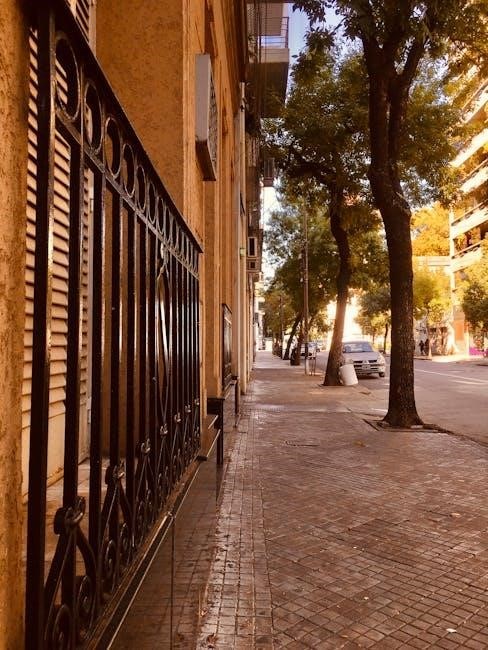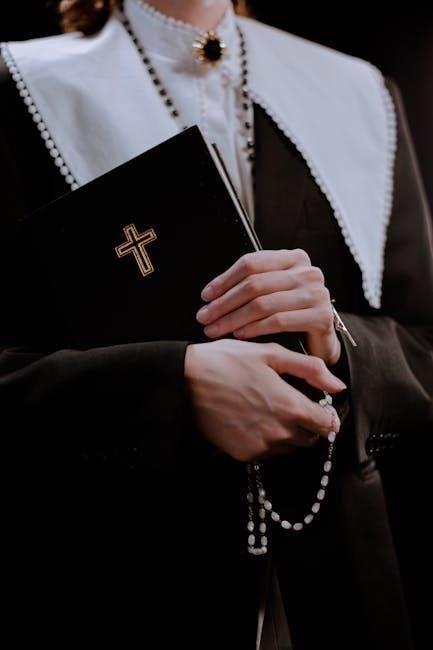The Rosary is a powerful prayer reflecting on the life of Christ through meditation on sacred mysteries, especially the Luminous Mysteries on Thursdays. This guide provides a structured approach to praying the Rosary, including the Apostles’ Creed, Our Father, Hail Mary, and Glory Be prayers, while offering reflections for each mystery to deepen your spiritual journey and connection with Christ and the Blessed Virgin Mary.
Significance of Thursday in the Rosary Tradition
Thursday holds a special place in the Rosary tradition as it is dedicated to the Luminous Mysteries, which reflect the revelation of Christ’s divine nature. This day is closely associated with the Institution of the Eucharist, as it commemorates the Last Supper, where Jesus established the sacrament of Holy Communion. The Luminous Mysteries, prayed on Thursdays, highlight key events in Christ’s public ministry, such as His baptism, the miracle at Cana, and the Transfiguration. These mysteries emphasize Christ’s mission and divine identity, inviting prayerful reflection on His teachings and miracles. By dedicating Thursday to these mysteries, the Rosary tradition encourages believers to deepen their understanding of Christ’s life and His gift of the Eucharist, fostering a spiritual connection to the heart of the Church’s sacramental life.
Overview of the Luminous Mysteries
The Luminous Mysteries, also known as the Mysteries of Light, are a set of five meditations introduced by Pope John Paul II. They emphasize key events in Christ’s public life that reveal His divine nature and mission. The first mystery is the Baptism of Christ in the Jordan, where the Holy Spirit descends upon Him. The second is the Wedding Feast at Cana, showcasing His first miracle. The third focuses on the Proclamation of the Kingdom of God, highlighting Christ’s teachings. The fourth mystery is the Transfiguration, where Christ’s divine glory is revealed. Finally, the Institution of the Eucharist commemorates the Last Supper and the establishment of the sacrament. These mysteries bridge the Joyful and Sorrowful Mysteries, offering a deeper understanding of Christ’s ministry and divine identity, and are traditionally prayed on Thursdays.

The Structure of the Rosary
The Rosary’s structure includes the Crucifix, Sign of the Cross, Apostles’ Creed, Our Father, three Hail Marys, Glory Be, and meditations on the Luminous Mysteries.
The Crucifix and the Sign of the Cross
The Rosary begins with the Crucifix, symbolizing Christ’s sacrifice and resurrection. The Sign of the Cross is the opening prayer, invoking the Trinity. It is a profound gesture of faith, renewing baptismal promises and dedicating the prayer to God. The Crucifix serves as a reminder of Christ’s love and redemption, while the Sign of the Cross unites the prayer in the name of the Father, Son, and Holy Spirit. This sacred gesture sets the tone for the Rosary, fostering devotion and mindfulness. The Crucifix is not just a symbol but a powerful focal point for meditation, connecting the prayer to the heart of Christian faith. Through this act, the prayer becomes a spiritual offering, honoring God and seeking His grace.
The Apostles’ Creed
The Apostles’ Creed is a foundational prayer in the Rosary, recited after the Sign of the Cross. It professes the Catholic faith, summarizing key beliefs about God, Jesus Christ, and the Holy Spirit. The Creed begins with “I believe in God, the Father almighty” and concludes with “the life everlasting.” It serves as a declaration of faith, uniting the prayer with the teachings of the Church. Reciting the Apostles’ Creed at the start of the Rosary sets a spiritual foundation, inviting reflection on the mysteries of Christ’s life. This ancient prayer connects believers across centuries, reaffirming their commitment to the Christian faith. Its inclusion in the Rosary emphasizes the unity of prayer and doctrine, preparing the heart for meditation on the sacred mysteries.

The Our Father Prayer
The Our Father, also known as the Lord’s Prayer, is a foundational Christian prayer taught by Jesus Christ. It begins with “Our Father, who art in heaven, hallowed be thy name,” and continues with requests for God’s will, forgiveness, and protection. This prayer is central to the Rosary, recited at the start of each rosary and before each decade of Hail Marys. On Thursdays, when praying the Luminous Mysteries, the Our Father connects the believer to Christ’s divine revelations, such as His baptism and the institution of the Eucharist. It emphasizes unity with God and the Church, seeking harmony with His will. The Our Father bridges the earthly and heavenly realms, fostering humility, forgiveness, and trust in divine providence, making it a powerful opening to the Rosary’s meditative journey.
The Hail Mary Prayer
The Hail Mary is a beloved prayer honoring the Blessed Virgin Mary, rooted in Scripture and devotion. It begins with “Hail Mary, full of grace, the Lord is with thee,” reflecting the Angel Gabriel’s greeting at the Annunciation. The prayer continues with “Blessed art thou among women, and blessed is the fruit of thy womb, Jesus,” acknowledging Mary’s divine motherhood. It concludes with a request for her intercession: “Holy Mary, Mother of God, pray for us sinners, now and at the hour of our death. Amen.” Recited ten times in each decade of the Rosary, the Hail Mary invites meditation on the mysteries, fostering a deeper connection to Christ and Mary. On Thursdays, it accompanies the Luminous Mysteries, such as the Baptism of Christ and the Wedding Feast at Cana, emphasizing Mary’s presence in these revelations of Jesus’ divinity.
The Glory Be Prayer
The Glory Be Prayer, also known as the “Glory to the Father,” is a concise yet profound doxology that concludes each decade of the Rosary. It begins with “Glory be to the Father, and to the Son, and to the Holy Spirit,” acknowledging the divine nature of the Trinity. The prayer continues, “As it was in the beginning, is now, and ever shall be, world without end. Amen,” emphasizing the eternal and unchanging nature of God. This prayer serves as a moment of praise and adoration, glorifying God for His majesty and grace. Recited after each decade, it provides a transition between mysteries, inviting deeper reflection and gratitude. On Thursdays, it beautifully complements the Luminous Mysteries, such as the Transfiguration, by highlighting the divine light and glory revealed in Christ’s life.

The Luminous Mysteries of Thursday
The Luminous Mysteries, prayed on Thursdays, reveal key moments in Christ’s public life: His baptism, the wedding at Cana, the kingdom’s proclamation, His Transfiguration, and the Eucharist’s institution.
The Baptism of Christ in the Jordan

The Baptism of Christ in the Jordan is the first Luminous Mystery, reflecting on Jesus’ divine revelation. John the Baptist baptizes Jesus, and the Holy Spirit descends as a dove, while God the Father declares, “This is My beloved Son.” This mystery highlights Jesus’ humility, obedience, and the beginning of His public ministry. It symbolizes the sacrament of Baptism, where believers are cleansed of sin and adopted as God’s children. Praying this mystery invites reflection on living a life of grace and fulfilling one’s divine mission. It also emphasizes the importance of spiritual renewal and the call to follow Christ’s example of surrender and trust in God’s plan. This mystery deepens devotion to Christ’s revelation and the Holy Trinity, offering a powerful meditation on faith and redemption.
The Wedding Feast at Cana
The Wedding Feast at Cana is the second Luminous Mystery, highlighting Mary’s intercession and Jesus’ first public miracle. At the request of His mother, Jesus turns water into wine, revealing His divine power and glory. This event underscores the importance of faith, obedience, and Mary’s role as a mediator of God’s grace. The miracle not only solves the practical problem of the wine shortage but also symbolizes the transformation of humanity through Christ. Praying this mystery invites reflection on trusting in God’s providence and seeking Mary’s intercession in times of need. It also reminds us of the joy and abundance that come from following God’s will, emphasizing the transformative power of faith and the divine plan in our lives. This mystery deepens devotion to Mary’s maternal care and Christ’s revelation as the Messiah.
The Proclamation of the Kingdom of God
The Proclamation of the Kingdom of God is the third Luminous Mystery, focusing on Jesus’ public ministry and His call to repentance and faith. After His baptism and the miracle at Cana, Jesus embarked on preaching the Good News, emphasizing the nearness of God’s Kingdom. This mystery reflects Christ’s mission to enlighten humanity about God’s love and the eternal life He offers. It invites prayer for the grace to live according to the Gospel, to embrace conversion, and to trust in God’s plan. The Rosary meditation on this mystery encourages believers to reflect on their commitment to spreading the Kingdom’s values of justice, peace, and love. By contemplating this mystery, we are reminded of the transformative power of faith and the call to actively live out Christ’s teachings in our daily lives, fostering a deeper connection to His divine mission. This reflection strengthens our resolve to follow God’s will and to share His message of hope and redemption with the world.
The Transfiguration of Christ
The Transfiguration of Christ is the fourth Luminous Mystery, highlighting a profound moment in Jesus’ ministry. On Mount Tabor, Jesus revealed His divine glory to Peter, James, and John, appearing with Moses and Elijah. This miraculous event confirmed Jesus’ identity as the Son of God and strengthened the disciples’ faith before His Passion. The Transfiguration serves as a reminder of Christ’s divine nature and the ultimate triumph of His resurrection. In prayer, this mystery invites us to seek a deeper understanding of God’s plan and to trust in His divine providence. Reflecting on this mystery, we ask for the grace to live according to Christ’s teachings and to embrace the hope of eternal life. It also symbolizes the transformative power of faith and the call to witness God’s glory in our lives.
The Institution of the Eucharist
The Institution of the Eucharist, the fifth Luminous Mystery, commemorates the Last Supper where Jesus instituted the Sacrament of the Eucharist. This profound moment occurred during the Passover meal, where Christ gave His disciples His Body and Blood, symbolizing the New Covenant. By commanding them to “do this in remembrance of Me,” Jesus established the Eucharist as a perpetual sacrifice and sacrament of His love. This mystery underscores the deep connection between the Eucharist and Christ’s sacrifice on the cross, emphasizing His unwavering love for humanity. Reflecting on this mystery, we are invited to deepen our devotion to the Eucharist and to live according to the commandment of love that Christ entrusted to His disciples; It also reminds us of the centrality of the Eucharist in Catholic worship and the transformative grace it brings to our lives.

How to Pray the Rosary on Thursday
Begin with the Sign of the Cross and Apostles’ Creed, then pray the Our Father, followed by ten Hail Marys, and conclude with the Glory Be. Reflect on each Luminous Mystery, focusing on their spiritual significance and connection to Christ’s life. End with a final prayer, seeking grace and blessings.
Starting the Rosary: The Sign of the Cross and Apostles’ Creed
The Rosary begins with the Sign of the Cross, a gesture of faith that invokes God’s blessings. Following this, the Apostles’ Creed is recited, professing belief in the Holy Trinity and the mysteries of Christ’s life, death, and resurrection. This opening prayer sets the tone for the Rosary, inviting reflection on the divine plan and the role of the Blessed Virgin Mary. The Sign of the Cross symbolizes redemption through Christ’s sacrifice, while the Creed establishes a foundation of faith, preparing the heart for meditation on the Luminous Mysteries. These initial prayers connect the believer to the Church’s teachings and the salvific events celebrated in the Rosary.
Praying the Our Father and Hail Marys
Following the Apostles’ Creed, the Rosary progresses with the Our Father prayer, which invites God’s will into our lives and seeks forgiveness for sins. This is followed by three Hail Marys, honoring the Blessed Virgin Mary and imploring her intercession. The Hail Mary reflects on her role in God’s plan and her maternal care for believers. Each decade of the Rosary begins with an Our Father, emphasizing unity with the Father and alignment with His divine plan. The repetition of the Hail Mary fosters devotion to Mary’s purity and grace, while the prayers collectively deepen meditation on the Luminous Mysteries. This rhythm of prayer cultivates a spirit of humility, repentance, and gratitude, drawing the faithful closer to Christ and His Mother.
Reflecting on Each Mystery
Reflecting on each mystery is the heart of the Rosary, inviting deeper meditation on the life of Christ and His divine revelation. Each of the Luminous Mysteries—such as the Baptism of Christ, the Wedding Feast at Cana, and the Institution of the Eucharist—offers a unique opportunity to connect with the Gospel narrative. During prayer, take a moment to visualize the scene, contemplate its spiritual significance, and allow the Holy Spirit to illuminate your understanding. Reflecting on these events fosters a deeper appreciation of Christ’s mission and Mary’s role as a disciple and mother. This meditation enriches your prayer, helping you apply the teachings and graces of each mystery to your daily life, fostering a profound and personal relationship with Christ and His Mother. Through reflection, the Rosary becomes a transformative encounter with God’s love and mercy.
Concluding the Rosary with the Glory Be and Final Prayer
Concluding the Rosary with the Glory Be and a final prayer is a meaningful way to seal your devotion and thanksgiving. After praying the fifth mystery, recite the Glory Be to honor the Holy Trinity. This prayer, also known as the Doxology, expresses praise and adoration for God’s eternal glory. Following this, many faithful recite the Hail Holy Queen prayer, seeking Mary’s intercession and protection. You may also add a personal prayer or intention, such as asking for the Pope’s intentions or the needs of the Church. This final segment is a moment to surrender to God’s will and express gratitude for the blessings received through the Rosary. It strengthens your spiritual resolve and deepens your connection with Christ and the Blessed Virgin Mary, bringing the prayer to a heartfelt and reverent close.

Prayer Intentions for Thursday’s Rosary
Prayer intentions for Thursday’s Rosary guide your meditation, dedicating each mystery to specific needs. Pray for the Pope, the Church, and personal intentions, aligning your devotion with Christ’s divine revelations.

Dedicating Each Mystery to a Specific Intention
Dedicating each mystery to a specific intention enriches your Thursday Rosary prayer. For the Baptism of Christ, pray for spiritual renewal and enlightenment. At the Wedding Feast of Cana, intercede for families and relationships. During the Proclamation of the Kingdom, seek strength to live according to God’s will. The Transfiguration can inspire prayers for clarity and faith, while the Institution of the Eucharist invites gratitude for the sacraments. Each mystery offers a unique opportunity to align your intentions with Christ’s divine plan, fostering a deeper connection to His mission and grace.
Praying for the Pope and the Church
Praying for the Pope and the Church is a vital aspect of Thursday’s Rosary. During the Luminous Mysteries, offer each decade for the intentions of the Holy Father and the universal Church. Reflect on Christ’s institution of the Eucharist, seeking unity and strength for all believers. Invoke Mary’s intercession for the Church’s guidance and protection. This practice fosters solidarity with the global Catholic community, aligning your prayers with the Pope’s monthly intentions; By doing so, you contribute to the spiritual renewal and mission of the Church, embodying the Rosary’s role in uniting the faithful worldwide.
Offering Prayers for Personal Intentions
Thursday’s Rosary provides an opportunity to offer prayers for personal intentions. As you meditate on the Luminous Mysteries, dedicate each decade to specific needs or concerns. For instance, during the Baptism of Christ, pray for spiritual renewal, while the Wedding Feast at Cana can inspire petitions for family unity. The Proclamation of the Kingdom invites prayers for courage in sharing faith, and the Transfiguration offers a moment to seek clarity and hope. Conclude with the Institution of the Eucharist, asking for grace to deepen your relationship with Christ. This practice allows you to weave personal devotion into the universal prayer of the Rosary, making it a powerful tool for spiritual growth and discernment in your daily life.

Blessings and Benefits of Praying the Rosary on Thursday

Praying the Rosary on Thursday brings spiritual graces, fostering peace, wisdom, and hope. It deepens devotion to Christ and Mary, while nurturing a habit of daily prayer.
Spiritual Graces and Fruits of the Rosary
Praying the Rosary on Thursday is a powerful devotion that offers numerous spiritual graces and fruits. This practice deepens one’s relationship with Christ and the Blessed Virgin Mary, fostering peace, wisdom, and hope. Regular recitation of the Rosary on Thursdays is known to bring clarity of mind, strength in faith, and comfort in times of sorrow. It also nurtures a habit of daily prayer, allowing believers to stay connected with divine grace. By reflecting on the Luminous Mysteries, one can grow in understanding the revelations of Jesus’ divinity. This devotion not only enriches personal spirituality but also strengthens the community of faith, uniting prayers for the Church and the world.
Deepening Devotion to Christ and the Blessed Virgin Mary
Praying the Rosary on Thursday, especially focusing on the Luminous Mysteries, deeply enriches one’s devotion to Christ and the Blessed Virgin Mary. This practice encourages meditation on key events in Christ’s life, such as His baptism, miracles, and the institution of the Eucharist, which highlight His divine nature. By contemplating these mysteries, individuals grow closer to Christ, fostering a deeper understanding of His mission and love. Simultaneously, the Rosary honors Mary’s role as a spiritual mother, guiding believers to her Son. This devotion strengthens one’s connection to both Christ and Mary, promoting a life of faith, love, and service. Regular prayer on Thursdays helps cultivate a profound and enduring relationship with the Holy Family, fostering spiritual growth and renewal.
Building a Habit of Daily Prayer
Praying the Rosary on Thursday fosters a consistent and meaningful habit of daily prayer. By dedicating time each week to reflect on the Luminous Mysteries, individuals cultivate a deeper connection with Christ and Mary, fostering spiritual discipline. This regular practice encourages mindfulness and introspection, helping to integrate prayer into daily life. The structured format of the Rosary—combining vocal prayer with meditation—provides a holistic approach to worship. Over time, this habit strengthens one’s relationship with God, promotes emotional and spiritual balance, and nurtures a sense of peace and purpose. Consistent prayer also enhances one’s ability to discern God’s will and live according to His teachings, leading to a more fulfilling and faith-centered life.